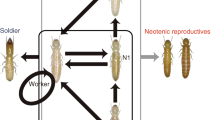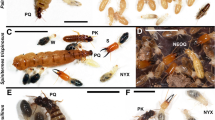Abstract
Sexual specialization and skewed sex ratios of the altruistic castes, especially soldiers, are common in many termite taxa. However, no theoretical or empirical studies have explained the origin of the sexual division of labor in termites. In most termite species, female alates are larger than male alates, and mature queens are much larger than kings, with females under consistent selection for high fertility. Therefore, females usually have the potential to be larger than males. Here, I present a novel preadaptation hypothesis that potential sexual differences in the suitability for the caste give rise to the sexual division of labor, and I provide the first evidence in support of this hypothesis in termites. Defense in Reticulitermes is typically performed by soldiers via mandibular and phragmotic defense in which soldiers with pluglike heads block openings, thus preventing enemies from invading the nest. Phragmotic defense requires that soldiers have heads wide enough to plug nest openings. Therefore, a size threshold for workers that develop into soldiers is a likely adaptation for effective defense. I show that sexual size dimorphism (SSD) and a size threshold for soldiers promote skewed sex ratios. A female-biased soldier sex ratio was observed in species with SSD, whereas there was no bias in soldier sex ratio in species without SSD. Thus, SSD and soldier sex ratio data from several Reticulitermes species support the preadaptation hypothesis.
Similar content being viewed by others
References
Austin JW, Szalanski AL, Uva P, Bagneres AG, Kence A (2002) A comparative genetic analysis of the subterranean termite genus Reticulitermes (Isoptera : Rhinotermitidae). Ann Ent Soc Am 95:753–760
Blanckenhorn WU (2000) The evolution of body size: What keeps organisms small? Q Rev Biol 75:385–407
Boomsma JJ, Baer B, Heinze J (2005) The evolution of male traits in social insects. Annu Rev Entomol 50: 395–420
Buchli HR (1958) L’origine des castes et les potentialités ontogénétiques des termites européens du genre Reticulitermes Holmgren. Ann Sci Nat Zool 20:263–429
Deligne J, Quennedey A, Blum MS (1981) The enemy and defense mechanism of termites. In: Hermann HR (eds) Social insects vol. 2. Academic Press, New York, pp 1–76
Hrdy I (1985) The role of juvenile hormones and juvenoids in soldier formation in Rhinotermitidae. In: Watson JAL , Okot-Kotber BM, Noirot C (eds) Caste differentiation in social insects. Pergamon Press, Oxford, pp 245–249
Matsuura K (2002a) Colony-level stabilization of soldier head width for head-plug defense in the termite Reticulitermes speratus (Isoptera: Rhinotermitidae). Behav Ecol Sociobiol 51:172–179
Matsuura K (2002b) Sociobiology of the termite Reticulitermes speratus. Ph.D. thesis, Kyoto University, Kyoto, Japan
Miura T, Matsumoto T (1995) Worker polymorphism and division of labor in the foraging behavior of the black marching termite Hospitalitermes medioflavus, on Borneo Island. Naturwissenschaften 82:564–567
Noirot C (1969) Formation of castes in the higher termites. In: Krishna K, Weesner FM (eds) Biology of termites. Academic Press, New York, pp 311–350
Noirot C (1985) Pathways of caste development in the lower termites. In: Watson JAL, Okot-Kotber BM, Noirot C (eds) Caste differentiation in social insects .Pergamon Press, Oxford, pp 41–57
Roisin Y (2000) Diversity and evolution of caste patterns. In: Abe T, Bignell DE, Higashi M (eds) Termites: Evolution, sociality, symbioses, ecology. Kluwer Academic Publishers, Dordrecht, Netherlands, pp␣95–119
Roisin Y (2001) Caste sex ratios, sex linkage, and reproductive strategies in termites. Insectes Soc 48:224–230
Roonwal ML (1975) Sex ratios and sexual dimorphism in termites. J Sci Ind Res 34:402–416
Scharf ME, Ratliff CR, Wu-Scharf D, Zhou XG, Pittendrigh BR, Bennett GW (2005) Effects of juvenile hormone III on Reticulitermes flavipes: changes in hemolymph protein composition and gene expression. Ins Biochem Mol Biol 35:207–215
Sokal RR, Rohlf FJ (1995) Biometry. The principles and practice of statistics in biological research. 3d ed. Freeman, New York
Shine R (1984) Ecological causes of the evolution of sexual dimorphism: arwview of the evidence. Q Rev Biol 64:419–441
Takematsu Y (1992) Biometrical study of the development of the castes in Reticulitermes speratus (Isoptera: Rhinotermitidae). Jpn J Entomol 60:67–76
Thorne BL (1983) Alate production and sex ratio in colonies of the Neotropical termite Nasutitermes corniger (Isoptera; Termitidae). Oecologia 58:103–109
Watson JAL (1973) The worker caste of the hodotermitid harvester termites. Insectes Soc 20:1–20
Wilson EO (1971) The insect societies. Harvard University Press, Cambridge
Wilson EO (2000) Sociobiology: The new synthesis 25th anniversary edition. Harvard University Press, Cambridge
Zimet M, Stuart AM (1982) Sexual dimorphism in the immature stages of the termite, Reticulitermes flavipes (Isoptera: Rhinotermitidae). Sociobiology 7:1–7
Acknowledgements
I thank Drs. N. E. Pierce, Takayoshi Nishida, Kenji Fujisaki and Fusao Nakasuji for useful discussion. This research was supported by funds from the Japan Society for the Promotion of Science (no. 03466, 06308 and 17770016) and funds from Inoue Foundation for Science.
Author information
Authors and Affiliations
Corresponding author
Rights and permissions
About this article
Cite this article
Matsuura, K. A novel hypothesis for the origin of the sexual division of labor in termites: which sex should be soldiers?. Evol Ecol 20, 565–574 (2006). https://doi.org/10.1007/s10682-006-9117-9
Published:
Issue Date:
DOI: https://doi.org/10.1007/s10682-006-9117-9




